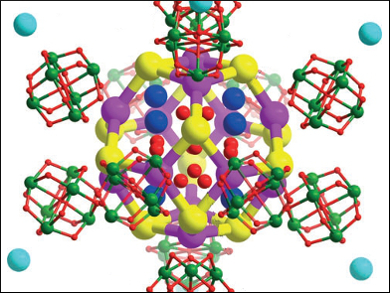Polyoxometalates (POMs) are metal-oxo nanoclusters of early transition metals, mainly V, Mo, W, Nb, and Ta. They have significant applications in catalysis, medicine, and materials science. A particularly fascinating area in POM chemistry concerns the incorporation of transition metal or lanthanide oxide clusters into POMs to construct composite heterometallic POM materials. Compared with V-, Mo-, and W-based heterometallic POMs, the construction of heterometallic polyoxoniobates (PONbs) proves much more difficult and remains largely unexplored.
Shou-Tian Zheng and a team at Fuzhou University, China, found to their surprise that as many as five distinctly different metals from the s, 3d, 4d, 5d, and 4f blocks can be integrated together to form a series of giant heterometallic PONbs with discrete or extended structures. They obtained the first series of niobium–tungsten–lanthanide heterometallic polyoxometalates {Ln12W12O36(H2O)24(Nb6O19)12} (Ln = Y, La, Sm, Eu, Yb) which are made of giant cluster-in-cluster-like ({Ln12W12}-in-{Nb72}) structures built from 12 hexaniobate {Nb6O19} clusters gathered together by a rare 24-nuclearity sodalite-type heterometal–oxide cage {Ln12W12O36(H2O)24}.
According to the researchers, the Nb-W-Ln clusters are the largest multi-metal polyoxoniobates and a series of rare high-nuclearity 4d-5d-4f multicomponent clusters. The giant clusters may be isolated as discrete inorganic alkali salts and can be used as building blocks to form high-dimensional inorganic–organic hybrid frameworks. According to the researchers, the integration of so many different metals into the same phase is truly extraordinary for crystalline materials made from solutions.
- Giant Hollow Heterometallic Polyoxoniobates with Sodalite-Type Lanthanide-Tungsten-Oxide Cages: Discrete Nanoclusters and Extended Frameworks,
Lu Jin, Xin-Xiong Li, Yan-Jie Qi, Ping-Ping Niu, Shou-Tian Zheng,
Angew. Chem. Int. Ed. 2016.
DOI: 10.1002/anie.201608113




